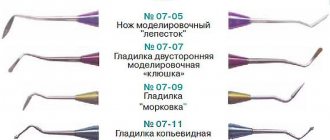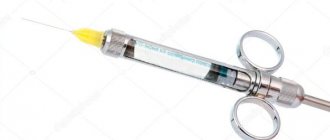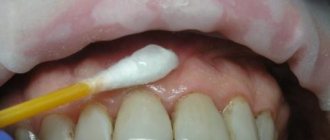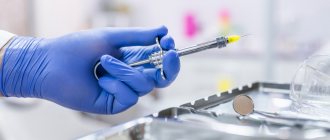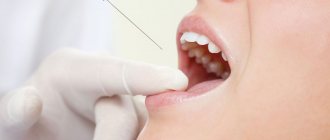Methods for treating dental defects and pathologies used in modern dental practice are practically not associated with painful sensations. A variety of anesthetic drugs, both local and general, eliminate the possibility of the patient experiencing discomfort during medical intervention. Moreover, each subsequent new product offered by the developers makes the pain relief procedure even simpler and more convenient. Among the existing options, carpule anesthesia deserves special attention, which will be discussed in this review.
What is carpule anesthesia?
Carpule anesthesia in dentistry is an injection anesthesia using a special syringe, which is called a carpule.
The use of a carpule syringe increases the safety and comfort of anesthesia.
That is, carpule anesthesia in dentistry can be of any type - the main thing is that a carpule syringe and the carpule itself with an anesthetic are used.
General overview
The name of the technique is due to the design of the syringe, the contents of which sharply reduce the sensitivity threshold of the nerve tissues of the tooth.
The capsule in which the drug is placed is called carpula. Despite the specific packaging of the drug, the manipulation technology itself is standard.
A carpule injection is a reusable syringe. This device is made of a medical metal alloy, and consists of a frame, a piston part and a needle. In this case, the piston cannot be completely removed from the housing, on the side of which there is a gap to accommodate the capsule.
It is a special ampoule containing an anesthetic composition. The capsule is hermetically sealed, has a rubber plug at one end, and a metal valve at the other.
The device works on the following principle - after the cartridge with the necessary product is placed in the gap of the syringe, a needle is screwed into it and an injection is made.
In this case, the plug should be on the side opposite to the needle. When you press the piston, the medicine is injected into the organ cavity and reaches the target.
Equipment
Essentially, a carpule syringe is a metal dental anesthesia syringe that can be used many times and is sterilized in the same way as other dental instruments. A carpule with an anesthetic is inserted into the carpule syringe - a special glass cartridge, factory-made.
Currently, the Trilogy Medical and Dental Center uses carpule syringes for injection anesthesia - they are much more convenient and more sophisticated than conventional disposable syringes.
Reasons for the lack of pain relief
In some cases, the effect of the product may be minimal or absent altogether, that is, tissue sensitivity remains almost at the same level.
There are reasons for this. If we exclude damage to the packaging and a violation of the properties of the composition, the lack of pain relief is explained by the following factors:
- fear of the upcoming procedure - fear blocks other reflexes, and anesthesia does not occur;
- production of adrenaline - it is intensely produced in moments of panic and enters the nerve cells, neutralizing the effect of the drug.
To exclude such manifestations, experts recommend that patients prone to panic fear of the dentist take a sedative half an hour before the procedure.
Chronic alcohol dependence, as well as the body’s addiction to the drug, can have an inhibitory effect.
Advantages of carpule pain relief
The most important advantages of carpulal anesthesia can be considered:
- The exact amount of the drug in 1 ampoule is exactly 1.7 ml. Thanks to this, the doctor can count the carpules and know exactly the dosage of the administered drug.
- Complete sterility. Carpules are manufactured and sealed in a warehouse under completely sterile conditions. This way you can be sure of the quality of the injected drug.
- Less pain from the injection itself. Patients feel less pain when punctured because the needle of a carpule syringe is much thinner and more flexible than that of a regular syringe.
- It is more convenient for the doctor to control the process. The dental anesthesia carpule syringe fits very comfortably in the hand thanks to special handles and stops. Also due to the greater flexibility of the needle, it can be bent in almost any direction without fear of it breaking off.
- Elimination of errors. When using Carpules, the possibility that the doctor will administer the wrong drug or in the wrong quantity or concentration is completely eliminated. After all, with carpule anesthesia, the doctor always knows exactly what he is injecting - the name of the drug, its concentration and quantity is written on each carpule.
Advantages and disadvantages of the method
Compared to analog painkillers, carpule anesthesia has the following advantages:
- high-precision dosing;
- 100% sterility (a disposable needle is used for each injection);
- compliance of the capsule contents with antiseptic requirements;
- portability (due to its high thinness, the insertion of the needle is almost imperceptible);
- ease of administration in places where soft tissues are close to the periosteum;
- a design that is comfortable to hold in your hand and point in the desired direction;
- increased flexibility and strength of the needle, which eliminates the risk of injury;
- labeling of each carpule with the name and dosage of the drug.
No significant disadvantages of the method under consideration were found. For some patients, the disadvantage is the high cost of the drug, which is due to manufacturing costs and effectiveness. Any quality product has an appropriate price.
Another disadvantage is the limitation of formulation modification. It cannot be mixed with a vasoconstrictor, which is necessary in some clinical cases.
Features of application
The drug should only be used by an experienced doctor with knowledge of the pharmaceutical properties of pain medications. The packaging provides detailed information about the percentage of components of a particular drug.
The injection kit consists of:
- Anesthetic is a substance that reduces the pain threshold in the injection area. Most of these drugs belong to the group of amides (for example, articaine, prilocaine, lidocaine);
- vasoconstrictor - a substance that serves to activate vasoconstrictor functions, which increases the duration of the analgesic effect (for example, adrenaline or mesaton). The same substance slows down the process of leaching the drug from the work area.
Important! The vasoconstrictor should be prescribed with caution to patients suffering from cardiovascular diseases, diabetics, and elderly patients.
- antioxidants - sodium sulfites or bisulfites. Their task is to protect the vasoconstrictor from destruction that occurs when exposed to oxygen. They contain sulfur fragments and may cause an allergic reaction. Not used to treat patients with pathologies of the respiratory system;
- preservatives - necessary for the drug to retain its properties until opening;
- EDTA – a substance that binds metals;
- parabens - serve to ensure 100% sterility of the composition contained in the capsule, which is especially important for safe transportation to hot regions. The balanced composition ensures reliable protection of the injection from pathogenic microorganisms.
Additional recommendations
Before administering an injection to the working area, it is recommended to make sure that the patient is not allergic to the components of the medication. This will minimize the development of anaphylactic shock, which has a detrimental effect on the patient’s health.
Disadvantages of carpule anesthesia
Despite the minor disadvantages described below, carpule anesthesia in dentistry is currently considered the safest and most modern option for injecting an anesthetic.
- Higher price of equipment.
Carpule syringes are more expensive per unit than disposable syringes. This is due to the fact that syringes with carpules for anesthesia in dentistry are quite complex in design, plus really high-quality ones will cost more than simpler options.
- It is impossible to change the concentration of anesthetic inside the cartridge - the cartridge is completely sealed and it is not possible to add anything inside.
Storage rules and periods
Any medicine needs proper storage. Capsules must be kept in a dark place. The optimal storage temperature is 23-25 degrees.
Failure to comply with basic conditions will shorten the shelf life of the composition, and improper transportation may compromise the structural integrity of the package.
Such drugs should not be used under any circumstances. Injectors should be stored in places inaccessible to children and pets.
Signs of loss of drug properties
You can understand that the medicinal effect of the drug has been neutralized and it has lost its main characteristics by a number of signs:
- the integrity of the packaging is compromised - most often this is due to careless transportation;
- An uncharacteristic sediment has appeared in the liquid or the shade of the composition has changed - this happens when the temperature regime is violated, causing overheating. The vasoconstrictor disintegrates and the agent changes its structural content;
- the appearance of gas bubbles larger than 0.2 cm. This is a consequence of freezing;
- the appearance of rust fragments on the outside of the ampoule.
How to find out that an infection has occurred during dental treatment and how to correct the situation.
In this article we will discuss methods of tooth restoration after endodontic treatment.
Here https://www.vash-dentist.ru/lechenie/zubyi/desensitayzeryi-v-stomatologii.html read about the importance of desensitizers in dentistry.
Conditions that local anesthetics must adhere to
In general, local anesthetics should:
- Do not cause allergies
- Have minimal toxicity to the body
- Have few side effects
- Easy to dissolve and excrete
In addition to this, anesthetic agents are required to:
- The effect is strong enough to completely anesthetize the tooth and surrounding tissues.
- Rapid numbness - no more than 5 minutes after the injection
- The numbness should last at least an hour - so that it is enough for the entire procedure, including the very last manipulations
- Anesthesia should take place no more than 2-3 hours later.
- Long-term stability of the drug itself – at least 2–3 years
Popular means
The most popular option for carpule anesthesia is the products of French manufacturers, which are effective and affordable:
- Ultracaine is the most popular concentration for dental pain relief. The effect occurs after a couple of minutes and lasts for at least an hour;
- Ubistezin - the duration of pain relief does not exceed half an hour, this time is sufficient in most clinical cases. Indications for use: children, pregnant women;
- Scandonest – has a high concentration of adrenaline. Side effect is a long-term vasoconstrictor result. Prevents bleeding;
- Septanest - has a mild effect. The sensitivity threshold remains extremely low for 15-20 minutes. Indicated for people prone to allergies, with severe pathologies and serious chronic diseases, when the use of stronger drugs is not recommended.
The best anesthetic – does it exist?
As we said above, almost all modern anesthetics are made on the basis of articaine, so there is not such a fundamental difference between them. Most patients are anesthetized with Ultracaine or Ubestezin.
But we must also take into account that, of course, it is important what is injected, but it is also important how it is done - a lot depends on the doctor and the technique of performing anesthesia.
Indications, contraindications and consequences of carpules anesthesia depend more on the type of anesthesia - infiltration or conduction, than specifically on the carpules. But, as we noted earlier, with carpule anesthesia there is no risk of administering the wrong drug and there is virtually no risk of the needle breaking off.
General and local anesthesia
What is used for pain relief in dentistry today? Two types of anesthesia are used - general (anesthesia) and local. The first type is rare and is used for extensive jaw surgeries. Anesthesia has a large number of contraindications and possible complications, and therefore in modern clinics the choice is in favor of local anesthesia. Moreover, its current level allows us to comfortably carry out treatment of caries, pulpitis, tooth extraction, prosthetics and other work.
Local anesthesia involves anesthetizing the area of intervention - turning off pain sensitivity, the patient is conscious. In most cases, tactile sensitivity is preserved (touching the cheek, gum, tooth, sensation of vibration, and so on).
The following types of anesthesia are used in dentistry:
- Applique . Only the mucous membrane is anesthetized using a special spray or gel. The rapid anesthetic effect allows further injection without pain. Used for removing stone and interventions at the gingival margin.
- Infiltration . An injection into the gum for pain relief in the upper jaw. The injection begins to act within 3-4 minutes, the freezing lasts for about an hour. Infiltration anesthesia is used in the treatment of pulpitis, deep caries, and tooth extraction. Complete absence of pain during treatment.
- Conductor . Anesthesia of the lower tooth, injection of an anesthetic into the area of the mandibular nerve. The nerve impulse along a fairly large cluster of nerves is blocked, and therefore the tongue and part of the lower jaw become numb. Naturally, anesthesia has a reversible effect and the nerve tissue is not damaged. The effect lasts for about two hours. Intraligamentary. Intraligamentous anesthesia, unlike conduction anesthesia, does not cause numbness of the tongue and part of the jaw, and therefore is actively used in pediatric dentistry when treating cavities and removing teeth. In adult patients, anesthesia is ineffective.
Which anesthetic to choose?
While a healthy person can afford almost any method of anesthesia, patients with serious diseases of the body must be extremely careful in choosing the drug. Thus, it is necessary to warn the dentist, who will anesthetize the oral cavity, about such health problems as disruptions in the endocrine system, high blood pressure, and a tendency to allergic reactions.
- Allergy sufferers and asthmatics can be given anesthetics that do not contain preservatives.
- For diabetics and patients with an enlarged thyroid gland, anesthesia that does not contain vasoconstrictor components - adrenaline and epinephrine - is recommended.
- For patients with compensated heart disease and a tendency to moderate increases in blood pressure, anesthesia is indicated, in which the concentration of vasoconstrictor components (epinephrine, adrenaline) is 1:200,000.
- Patients with progressive diseases of the cardiovascular system can be treated with drugs that do not contain adrenaline and epinephrine.
How to distinguish an original from a fake?
Karpula ensures the sterility of chemical compounds. It also serves to create the necessary pressure in the syringe, which is required during the aspiration test procedure.
The capsule is a cylindrical container made of glass or plastic with a silicone piston placed at one end and a rubber stopper covered with metal at the other end. The inside volume of the cartridge should be 2 ml. However, due to the presence of a stopper, the capacity can be reduced to 1.7-1.8 ml.
Due to incorrect transportation, storage, or the purchase of counterfeits, changes in the presentation of capsules or boxes may occur, which you should pay attention to:
- discrepancy between the color characteristics and density of the substance (yellowness, turbidity, sediment);
- the position of the piston does not correspond to the dimensions of the cartridge, however, bubbles may be observed in the middle of the capsule;
- rust is detected on the cartridge (seal failure);
- The boxes show signs of being dented or have any defects.
When choosing needles, you need to pay attention to the presence of certain quality characteristics that are adhered to by well-known pharmaceutical companies:
- Branded products have a red mark on the outside of the body (on the cut side of the tip).
- Certified products have a thread on the inside of the body into which a syringe of the appropriate size and shape is screwed, according to the type of device.
- Manufacturers package original needles in packages of 100 pieces.
- After sterilization at the factory, the cases are sealed with paper seals or using cutters.
- The labels must clearly indicate the manufacturer's data (location, name), needle marking (length, diameter), production time and shelf life of the product.
Dental treatment under general anesthesia or anesthesia
Anesthesia in dentistry is used less frequently than local anesthesia and is not an everyday decision, but rather an exceptional necessity when dental treatment under any other anesthesia is impossible.
Yes, the drugs used for general anesthesia are safe for the patient’s health and have minimal contraindications, but general anesthesia affects the WHOLE BODY, while local anesthesia affects only the necessary areas.
General anesthesia is indicated for:
- severe dental phobia - an insurmountable fear of treatment;
- for general diseases that cause inappropriate behavior of the patient, for example, epilepsy;
- complex surgical interventions requiring very long work by the surgeon;
- with allergic intolerance to all modern local anesthetics.
General anesthesia can only be used in a clinic specially equipped for this, which either has its own team of anesthesiologists, or it provides for the deployment of a visiting team with all the necessary equipment for resuscitation.
You need to understand that it is not the anesthesia itself that is dangerous, it is the clinic’s lack of medical equipment that is dangerous, and the administration of anesthesia by unqualified medical personnel is dangerous!
The main advantage of general anesthesia for dental treatment is the reduction of treatment time. During one visit, the doctor has the opportunity to remove or treat several teeth.
Selection of carpule needles
The carpule needle consists of a metal nozzle and a plastic coupling, with the help of which the spear is attached to the body. The product must guarantee effortless, painless injection of the medicinal substance.
It has 2 sides, with the help of which manipulations become harmless. The elongated side of the tip is used to penetrate dental tissues; it ends with a chamfer. The short side is a device for opening impenetrable carpules.
The criteria for selecting a device should be based on the following characteristics:
- Dentists recommend choosing a product that has a red mark indicating the direction of movement of the syringe. This can increase the level of medical manipulations and reduce the time a person spends in the dental chair.
- The metal for the manufacture of products is selected according to the parameters of thickness, reliability, and increased elasticity. This will help avoid infection and eliminate discomfort during the procedure, providing opportunities to reach the most inaccessible places in the oral cavity.
- Needles are selected according to length. There are products on sale with lengths from 10 to 25.5 mm (short) and 28.9-41.5 mm (long).
- Dentists also select needles based on diameter.
Foreign-made needles are more expensive; they are certified to European and American standards. The most expensive products include products from the company Septoject Evolution (a package of 100 pieces can cost 1000-1400 rubles), made from high quality metal.
Products made in Korea and Pakistan are much cheaper (300-500 rubles), which are also of good quality (brands NI-PRO, BIODENT, Sun Pharmaceuticals, Cornerstone Corporation). The cheapest needles will cost you Russian-made needles (AERS), which are not inferior in quality to their foreign counterparts.
All manufacturing companies produce products according to standard parameters of diameter and length: 12, 16, 21, 25, 30, 35, 38 mm.
Types of syringes
For carpule anesthesia, initially only reusable metal injectors were used. Surely many patients have seen these terrible syringes with three rings to support the dentist’s fingers: one at the end of the rod and two at the end of the body. Each injector is designed to provide carpule anesthesia for one patient. After the procedure, the syringe is sent for disinfection, where it undergoes a number of mandatory steps: disassembly, cleaning, sterilization, etc.
Today, reusable metal injectors have been replaced by disposable plastic ones. They are produced in sealed bags, which are opened in front of the patient immediately before carpule anesthesia. The design of the plastic injector is exactly the same, but it is smaller in size and lighter in weight.
The main feature and advantage of disposable carpule syringes is their safety for medical staff. When working with a metal injector, the following often happens: the dentist removes the cap from the needle, administers anesthesia, then, when putting the cap on, misses and pricks.
Curious! A dentist who accidentally pricks his finger on a needle that he has just used for local anesthesia can instantly become infected with various infectious diseases: from hepatitis to HIV.
For plastic injectors, special needles are produced with an additional cap that protects the doctor from accidental microtrauma. This cap is easily pulled out after anesthesia and allows you to remove and then dispose of the needle without the risk of pricking yourself and becoming infected.
Reviews
Carpule anesthesia is used almost everywhere in domestic clinics.
Its main purpose is to eliminate the fear of treatment and make it as comfortable as possible.
If you are interested in this article, you can leave your comment in the appropriate section. Surely your opinion will be useful to someone.
If you find an error, please select a piece of text and press Ctrl+Enter.
Tags
Did you like the article? stay tuned
Previous article
Septopak in dentistry - a material for reliable protection
Next article
Lotus braces are a guarantee of quick and reliable correction of any bite defects
General anesthesia in dentistry: objective indications
It would hardly be correct to consider general anesthesia a solution for those who are simply afraid of dentists. This is a serious procedure for which there must be objective reasons. However, in some cases, general anesthesia - the administration of narcotic analgesics by inhalation or intravenously to completely turn off consciousness - has its advantages.
- Pathological panic and fear of dental procedures, inability to administer anesthesia by injection, patient's immunity to sedatives. If such a patient needs to undergo dental surgery - to remove an abscess or large cystic formation, to clean necrotic tissue formed as a result of purulent inflammation on the jaw bone - general anesthesia cannot be avoided.
- Serious psychological or neurological disorders in which the patient cannot behave adequately during the treatment process and correctly comply with the requests of the dentist.
- Pathologically increased gag reflex.
It is important to understand that treatment under general anesthesia must be carried out in a hospital setting. In addition to the dentist and nurse, the presence of an anesthesiologist is mandatory.




